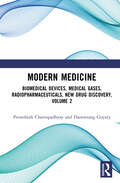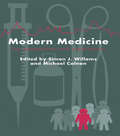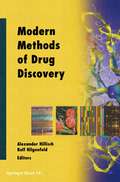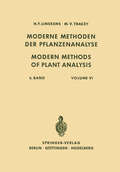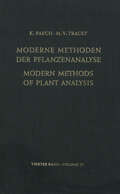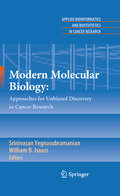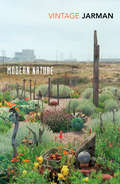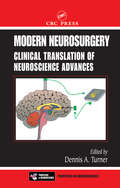- Table View
- List View
The Modern Management of Mental Handicap: A Manual of Practice
by G. B. SimonThe aim of this book is to provide parents, staff and others involved with mentally handicapped children and adults with up to-date basic information and advice in their management. Methods of care, treatment and management of a heterogeneous group of people such as the mentally handicapped must of necessity include many disciplines if they are to be given an adequate service. This book is an attempt to bring the knowledge and experience of many people together. The size of the book could have been increased to include more detail on other aspects of the subject but this might easily have diminished its value as a convenient reference to as wide a readership as possible, both professional and non-professional. The contents deal essentially with the needs of the severely mentally handicapped and should have an application in most parts of the world. Much of the information and advice on services, and on treatment and management, is based on the experience of specialists working in the United Kingdom, this now being standard practice in most parts of the world.
Modern Management of Obstructive Sleep Apnea
by Salam O. SalmanThis book provides detailed, specific information regarding the non-surgical and surgical treatment modalities currently employed for the management of obstructive sleep apnea (OSA) with the aim of enabling practitioners to achieve optimal outcomes in individual patients. The book opens by offering clear guidance on the medical and surgical evaluation of patients with OSA. Coverage of medical management options includes positive airway pressure therapy, positional therapy, the use of mandibular repositioning devices, along with other treatment modalities. Surgical interventions are then exhaustively described in a series of chapters that document the approaches to specific sites of obstruction. Information is included on operative airway management, and the concluding chapter addresses the care of pediatric patients. Modern Management of Obstructive Sleep Apnea will be a valuable asset for oral and maxillofacial surgeons, otolaryngologists, and sleep medicine physicians.
Modern Medicine: Biomedical Devices, Medical Gases, Radiopharmaceuticals, New Drug Discovery, Volume 2
by Pronobesh Chattopadhyay Danswrang GoyaryModern Medicine: Biomedical Devices, Medical Gases, Radiopharmaceuticals, New Drug Discovery, Volume 2 discusses the procedures of drug approval and regulatory requirements that must be met according to the United States Food and Drug Administration (FDA), the European Medical Agency (EMA), and the Central Drug Standard Control Organization (CDSCO). In the rapidly evolving landscape of modern medicine, groundbreaking innovations have emerged that are reshaping the way we approach healthcare. Modern Medicine delves into the cutting-edge realms of medical devices, medical gases, radiopharmaceuticals, and new drug discovery, offering a comprehensive exploration of these transformative fields that are revolutionizing patient care and medical practices. Discover the future of healthcare technology, and uncover the intricate world of biomedical engineering, where state-of-the-art devices seamlessly merge with the human body to monitor, diagnose, and treat ailments Dive deep into the utilization of medical gases for respiratory conditions, pain management, and even novel applications in regenerative medicine Unravel the mysteries of radiopharmaceuticals, a fusion of molecular imaging and therapy that offers unprecedented insights into the inner workings of the human body Embark on a journey through the intricate processes of drug discovery, where groundbreaking research and cutting-edge technologies are yielding therapies that were once deemed impossible Modern Medicine is a must-read for medical professionals, researchers, students, and anyone intrigued by the remarkable intersection of science, technology, and patient well-being. Join us on a journey to the forefront of medical innovation, where the unimaginable becomes reality, and the future of healthcare takes shape before our eyes. The chapter on regulatory implications for the approval process in this book will be the most useful resource for researchers and students, particularly those with backgrounds in pharma, forensic medicine, regulatory affairs, or those who aspire to succeed in drug research. Additionally, the information contained in this volume of the book could be of great interest to researchers working in the pharmaceutical and health industries.
Modern Medicine: Biomedical Devices, Medical Gases, Radiopharmaceuticals, New Drug Discovery, Volume 2
by Pronobesh Chattopadhyay Danswrang GoyaryModern Medicine: Biomedical Devices, Medical Gases, Radiopharmaceuticals, New Drug Discovery, Volume 2 discusses the procedures of drug approval and regulatory requirements that must be met according to the United States Food and Drug Administration (FDA), the European Medical Agency (EMA), and the Central Drug Standard Control Organization (CDSCO). In the rapidly evolving landscape of modern medicine, groundbreaking innovations have emerged that are reshaping the way we approach healthcare. Modern Medicine delves into the cutting-edge realms of medical devices, medical gases, radiopharmaceuticals, and new drug discovery, offering a comprehensive exploration of these transformative fields that are revolutionizing patient care and medical practices. Discover the future of healthcare technology, and uncover the intricate world of biomedical engineering, where state-of-the-art devices seamlessly merge with the human body to monitor, diagnose, and treat ailments Dive deep into the utilization of medical gases for respiratory conditions, pain management, and even novel applications in regenerative medicine Unravel the mysteries of radiopharmaceuticals, a fusion of molecular imaging and therapy that offers unprecedented insights into the inner workings of the human body Embark on a journey through the intricate processes of drug discovery, where groundbreaking research and cutting-edge technologies are yielding therapies that were once deemed impossible Modern Medicine is a must-read for medical professionals, researchers, students, and anyone intrigued by the remarkable intersection of science, technology, and patient well-being. Join us on a journey to the forefront of medical innovation, where the unimaginable becomes reality, and the future of healthcare takes shape before our eyes. The chapter on regulatory implications for the approval process in this book will be the most useful resource for researchers and students, particularly those with backgrounds in pharma, forensic medicine, regulatory affairs, or those who aspire to succeed in drug research. Additionally, the information contained in this volume of the book could be of great interest to researchers working in the pharmaceutical and health industries.
Modern Medicine: Lay Perspectives And Experiences
by Simon J. Williams Michael CalnanDo lay people view modern medicine as a fountain of hope or a font of despair? What are their experiences of modern medical care and technology, and how do their views and experiences differ across different social groups? Combining theoretical insights with a range of qualitative and ethnographic research, this volume examines lay experiences and evaluation of medicines and drugs, chronic illness and life-saving technology, and reproductive technologies. It also considers the growing popularity of complementary therapies as a potential challenge to orthodox medicine.
Modern Medicine: Lay Perspectives And Experiences
by Simon J. Williams Michael CalnanDo lay people view modern medicine as a fountain of hope or a font of despair? What are their experiences of modern medical care and technology, and how do their views and experiences differ across different social groups? Combining theoretical insights with a range of qualitative and ethnographic research, this volume examines lay experiences and evaluation of medicines and drugs, chronic illness and life-saving technology, and reproductive technologies. It also considers the growing popularity of complementary therapies as a potential challenge to orthodox medicine.
Modern Menopausal Hormone Treatment: Facts and Myths About Sex Hormones
by Hilde LöfqvistThis unique book is structured to give the reader a comprehensive view to understand the decline of hormones at midlife and the risks and benefits of evidence based hormonal treatments. The difference between bio-identical and synthetic hormones is shown.With this book the author intends to restore the trust of the mostly positive effects of hormone treatment during menopause. In this book effective hormone treatments that may be carried on for years are discussed. Those hormones may even prevent age related diseases (arthralgia, osteoporosis, cardiovascular diseases) if started at the right time frame directly after menopause, known as "window of opportunity". This book fills a gap for medical health providers and can be of benefit for all women searching evidence-based information and answers on hormone menopausal changes and treatments. The book provides the reader with case histories to show how different women are at the menopausal transition, and what the doctor has to consider in the choice of investigation and treatment.
Modern Meta-Analysis: Review and Update of Methodologies
by Ton J. Cleophas Aeilko H. ZwindermanModern meta-analyses do more than combine the effect sizes of a series of similar studies. Meta-analyses are currently increasingly applied for any analysis beyond the primary analysis of studies, and for the analysis of big data. This 26-chapter book was written for nonmathematical professionals of medical and health care, in the first place, but, in addition, for anyone involved in any field involving scientific research. The authors have published over twenty innovative meta-analyses from the turn of the century till now. This edition will review the current state of the art, and will use for that purpose the methodological aspects of the authors' own publications, in addition to other relevant methodological issues from the literature.Are there alternative works in the field? Yes, there are, particularly in the field of psychology. Psychologists have invented meta-analyses in 1970, and have continuously updated methodologies. Although very interesting, their work, just like the whole discipline of psychology, is rather explorative in nature, and so is their focus to meta-analysis. Then, there is the field of epidemiologists. Many of them are from the school of angry young men, who publish shocking news all the time, and JAMA and other publishers are happy to publish it. The reality is, of course, that things are usually not as bad as they seem. Finally, some textbooks, written by professional statisticians, tend to use software programs with miserable menu programs and requiring lots of syntax to be learnt. This is prohibitive to clinical and other health professionals. The current edition is the first textbook in the field of meta-analysis entirely written by two clinical scientists, and it consists of many data examples and step by step analyses, mostly from the authors' own clinical research.
Modern Methods for Epidemiology
by Yu-Kang Tu and Darren C. GreenwoodRoutine applications of advanced statistical methods on real data have become possible in the last ten years because desktop computers have become much more powerful and cheaper. However, proper understanding of the challenging statistical theory behind those methods remains essential for correct application and interpretation, and rarely seen in the medical literature. Modern Methods for Epidemiology provides a concise introduction to recent development in statistical methodologies for epidemiological and biomedical researchers. Many of these methods have become indispensible tools for researchers working in epidemiology and medicine but are rarely discussed in details by standard textbooks of biostatistics or epidemiology. Contributors of this book are experienced researchers and experts in their respective fields. This textbook provides a solid starting point for those who are new to epidemiology, and for those looking for guidance in more modern statistical approaches to observational epidemiology. Epidemiological and biomedical researchers who wish to overcome the mathematical barrier of applying those methods to their research will find this book an accessible and helpful reference for self-learning and research. This book is also a good source for teaching postgraduate students in medical statistics or epidemiology.
Modern Methods in Analytical Morphology
by J. Gu G. W. HackerWhile advances in modem medicine largely parallel our understanding of morphology, discoveries in morphology are propelled by developments of new tools and means to visualize and measure tissue elements. The invention of dissecting, light, fluorescence and electron microscopes together with advances in labeling and staining techniques are among the stepping stones of morphological progress. Today, we are in an exciting new era when classical morphology is being combined with developments from other disciplines. The combination of morphology and immunology resulted in immunocytochemistry; morphology and molecular biology led to in situ hybridization and in situ PCR. Adding computer science to morphology gave birth to image analysis. Combining laser technology and the microsope evolved into confocal microscope. For more than a decade, modem morphology has continued to develop by merging with other disciplines at a rate that is still gathering momentum, providing exciting and dynamic new frontiers for other biological fields. "Modem Methods in Analytical Morphology," based largely on the "First International Workshop on Modem Methods in Analytical Histochemistry, "is an updated review of the current trends in the field. It covers an extensive array of new technical developments in major disciplines of modem morphology. The authors are not only leaders in their fields but also have extensive "hands on" experience with "bench work. " Their chapters are written in a comprehensive manner including discussion of both theoretical considerations and practical applications to give the readers a broad view of the topics covered.
Modern Methods in Neurosurgery (Advances in Neurosurgery #16)
by MarioBrock MargaretaKlinger MathiasBrandt WendelinWalterThis 16th volume of Advances in Neurosurgery contains a selection of pa pers presented at the 38th Annual Meeting of the German Society of Neurosurgery, held in Munster on 3-6 May 1987. The program committee had to choose these contributions from a total of 161 presentations. I am very much obliged to the members of the committee who contributed their experience and effort to the organization of the scientific pro gram: Prof. Dr. R.A. Frowein, Prof. Dr. W.J. Bock, Prof. Dr. E. Kazner, Prof. Dr. G. Lausberg, Prof. Dr. M. Klinger, and Prof. Dr. M. Brandt. The aim of the Meeting was to exchange experiences regarding modern diagnostic and therapeutic achievements. The first main topic was new technical methods in neurosurgery. Refinements in laser technology were introduced; different laser devices have been recognized as use ful tools in microsurgery and some peripheral nerve problems. The Ca vitron ultrasonic aspirator has proven its value in a great variety of intracranial and spinal tumors within a few years. Its technical advance is impressively demonstrated by some of the papers in this book. With growing experience we have recognized the great value of these additional instruments in limited surgical fields and learned not to overestimate them in the hands of a skilled neurosurgeon.
Modern Methods of Drug Discovery (Experientia Supplementum #93)
by Dr Prof.Research in the pharmaceutical industry today is in many respects quite different from what it used to be only fifteen years ago. There have been dramatic changes in approaches for identifying new chemical entities with a desired biological activity. While chemical modification of existing leads was the most important approach in the 1970s and 1980s, high-throughput screening and structure-based design are now major players among a multitude of methods used in drug discov ery. Quite often, companies favor one of these relatively new approaches over the other, e.g., screening over rational design, or vice versa, but we believe that an intelligent and concerted use of several or all methods currently available to drug discovery will be more successful in the medium term. What has changed most significantly in the past few years is the time available for identifying new chemical entities. Because of the high costs of drug discovery projects, pressure for maximum success in the shortest possible time is higher than ever. In addition, the multidisciplinary character of the field is much more pronounced today than it used to be. As a consequence, researchers and project managers in the pharmaceutical industry should have a solid knowledge of the more important methods available to drug discovery, because it is the rapidly and intelligently combined use of these which will determine the success or failure of preclinical projects.
Modern Methods of Pharmaceutical Analysis, Second Edition, Volume II
by Roger E. SchirmerThis book reviews several of the newer methods that find wide application in pharmaceutical analysis, as well as several older methods of unique importance. The principle of each technique is discussed with emphasis on factors that directly affect its proper application to analytical problems .
Modern Methods of Pharmaceutical Analysis, Second Edition, Volume II
by Roger E. SchirmerThis book reviews several of the newer methods that find wide application in pharmaceutical analysis, as well as several older methods of unique importance. The principle of each technique is discussed with emphasis on factors that directly affect its proper application to analytical problems .
Modern Methods of Plant Analysis / Moderne Methoden der Pflanzenanalyse (Modern Methods of Plant Analysis Moderne Methoden der Pflanzenanalyse #6)
by H. F. Linskens M. V. Tracey Ulrich Beiss Fay Bendall Walter Björk F. Bohlmann Hans G. Boman Richard Braun W. Heinen Manfred Hesse Eduard Hofmann J. R. Hudson Rüdiger Knapp Rudolf Lambert Carlos O. Miller Gerhard Pfleiderer B. D. Sanwal Hans Schmid Shoji Shibata Herbert Stern Wolfgang Sucrow Josef Tobiška F. W. ZillikenModern Methods of Plant Analysis / Moderne Methoden der Pflanzenanalyse: Volume 4 (Modern Methods of Plant Analysis Moderne Methoden der Pflanzenanalyse #4)
by K. Paech M. V. TraceyModern Microtia Reconstruction: Art, Science, and New Clinical Techniques
by John F. Reinisch Youssef TahiriMicrotia is a rare congenital deformity where the external ear is underdeveloped or absent. Occurring on average in one out of 12,000 children born in the world, there are very few books dedicated to ear reconstruction and microtia, specifically. Microtia reconstruction is a relatively uncommon and notoriously difficult procedure, where hearing as well as external ear deformity need to be addressed. This book is the result of 30 years dedicated to the surgical treatment of microtia: understanding in depth the pathophysiology and trying various surgical techniques to provide long lasting and pleasing aesthetic and functional results. With the limited amount of published information on microtia and ear reconstruction, Modern Microtia Reconstruction shines significant light on the new techniques and advances currently available. It presents advanced surgical techniques alongside inventive approaches that will lay the foundation on which surgeons can continue to expand their knowledge and know-how of the surgical approach of ear reconstruction. While the literature that is currently available on ear reconstruction focuses primarily on cartilage-based surgery, this book explores several other techniques detailing their advantages and disadvantages for both the surgeon and the patient discussing techniques for primary ear reconstruction, secondary ear reconstruction, reconstruction in the unsatisfied patient, as well as for post-traumatic ear reconstruction. Providing not only full-color images and illustrations but extensive video clips of each surgical technique to truly see and experience the subtleties of the surgery in a variety of patients. The primary audience is plastic surgeons, ENT surgeons, oral/maxillofacial surgeons, audiologists, physician’s assistants, and nurse practitioners with a secondary audience of course being highly knowledgeable parents of patients with microtia. With over a quarter of a century experience between the two editors, this book represents a major advance in showing a reliable approach to ear reconstruction surgery
Modern Mitral Valve Repair: Echocardiographic Interpretations and Surgical Strategies
by Choi-Keung NgPreoperative and intraoperative echocardiography has become an indispensable tool for guiding mitral valve surgery and has fostered the development of many innovative surgical techniques. Mitral valvuloplasty is now an established surgical method for the treatment of mitral insufficiency but the success is largely dependent on the extent of the underlying disease of the mitral valve. The book by Dr. Ng and coauthors is an extraordinary presentation of the relation between echocardiographic display of mitral valve pathology and reconstructive mitral valve surgery. The atlas provides an excellent illustrative guide to teach echocardiographic-anatomic correlations and educates the reader on the techniques of mitral valve repair. The quality of the illustrations, particularly the surgical photographs is exquisite. The book will be helpful for cardiologists and cardiac surgeons.
Modern Molecular Biology: Approaches for Unbiased Discovery in Cancer Research (Applied Bioinformatics and Biostatistics in Cancer Research)
by Srinivasan Yegnasubramanian William B. B. IsaacsMolecular biology has rapidly advanced since the discovery of the basic flow of information in life, from DNA to RNA to proteins. While there are several important and interesting exceptions to this general flow of information, the importance of these biological macromolecules in dictating the phenotypic nature of living creatures in health and disease is paramount. In the last one and a half decades, and particularly after the completion of the Human Genome Project, there has been an explosion of technologies that allow the broad characterization of these macromolecules in physiology, and the perturbations to these macromolecules that occur in diseases such as cancer. In this volume, we will explore the modern approaches used to characterize these macromolecules in an unbiased, systematic way. Such technologies are rapidly advancing our knowledge of the coordinated and complicated changes that occur during carcinogenesis, and are providing vital information that, when correctly interpreted by biostatistical/bioinformatics analyses, can be exploited for the prevention, diagnosis, and treatment of human cancers. The purpose of this volume is to provide an overview of modern molecular biological approaches to unbiased discovery in cancer research. Advances in molecular biology allowing unbiased analysis of changes in cancer initiation and progression will be overviewed. These include the strategies employed in modern genomics, gene expression analysis, and proteomics.
Modern Natural Product Synthesis: Overcoming Difficulties
by Masahisa Nakada Keiji Tanino Kazuo Nagasawa Satoshi YokoshimaIn this book, key experts in the field of total synthesis of natural products in Japan describe the details of their synthesis routes including unexpected reactions and syntheses. By presenting detailed stories behind the total synthesis developments, including those routes that were unsuccessful the book provides the reader with a better understanding of how other researchers devise their strategy and overcome difficulties in their studies. The contributions in the book have focused on highlighting the research from Japan however it is appealing to researchers and students worldwide. This compilation of cutting-edge natural product synthesis provides high-quality expertise, especially to graduate students and young researchers, regarding research on synthetic organic chemistry. It can be utilized as teaching material in university seminars as well as provide guidance to researchers in the area of total synthesis.This is an open access book.
Modern Nature: The Journals of Derek Jarman (The\journals Of Derek Jarman Ser. #1)
by Derek JarmanA divine, meditative and inspiring diary of Derek Jarman's famous garden at Dungeness.'An essential – urgent – book for the 21st Century' Hans Ulrich ObristWITH AN INTRODUCTION BY OLIVIA LAINGIn 1986 Derek Jarman discovered he was HIV positive and decided to make a garden at his cottage on the barren coast of Dungeness. Facing an uncertain future, he nevertheless found solace in nature, growing all manner of plants. While some perished beneath wind and sea-spray others flourished, creating brilliant, unexpected beauty in the wilderness. Modern Nature is both a diary of the garden and a meditation by Jarman on his own life: his childhood, his time as a young gay man in the 1960s, his renowned career as an artist, writer and film-maker. It is at once a lament for a lost generation, an unabashed celebration of gay sexuality, and a devotion to all that is living.
Modern Neuromuscular Techniques (Advanced Soft Tissue Techniques)
by Leon ChaitowFully updated throughout, this popular book explains the history, rationale, and detailed descriptions of the class of soft tissue manipulation methods known collectively as NMT techniques. Complete with accompanying website - www.chaitowonline.com - which contains film sequences of the author demonstrating the techniques, this book will be ideal for bodyworkers and acupuncturists in Europe, the USA and beyond. - Facilitates the rapid and accurate identification of local soft-tissue dysfunction - Explains the origin of soft tissue distress - Provides diverse maps and explanations for the patterns of tender and trigger points seen daily in clinical practice - Includes guidance on the use of NMT for the treatment of the symptoms of fibromyalgia and abdominal dysfunction - Gives important guidance on the treatment of trigger points in treating lymphatic dysfunction - Discusses the use of NMT in the management of pain and hyperventilation - Explains the diagnostic and therapeutic value of tender reflex points related to viscero-somatic and somatic-visceral reflexes - Describes both European and North American versions of NMT - Provides a clear set of treatment options for all bodywork therapists and acupuncture practitioners - Authored by a highly respected, internationally known teacher, practitioner and author, with contributions from three leading practitioners from the U.S. and Europe - Contains a new chapter on the value of Thai Yoga massage, associated with NMT methodology - Contains source material and commentary on the contribution of Raymond Nimmo DC in the evolution of NMT - Website - www.chaitowonline.com - containing updated video clips demonstrating the application of NMT
Modern Neurosurgery: Clinical Translation of Neuroscience Advances
by Dennis A.Turner M.A.Focusing on how increased understanding of brain function affects clinical neuroscience, this incisive text explores the interface between neuroscience and clinical neuroscience advances by examining the hypotheses that drive this evolution. The author reviews the relevant underpinnings of new neurosurgical techniques, treatments, and conceptual ap
Modern Neurosurgery: Clinical Translation of Neuroscience Advances
by Dennis A. TurnerFocusing on how increased understanding of brain function affects clinical neuroscience, this incisive text explores the interface between neuroscience and clinical neuroscience advances by examining the hypotheses that drive this evolution. The author reviews the relevant underpinnings of new neurosurgical techniques, treatments, and conceptual ap
Modern Neurosurgery 1
by Mario BrockMore than 800 papers were presented by neurosurgeons from 66 countries during the 7th International Congress of Neurological Surgery, held in Munich on 12-18 July 1981. With the present scope and problems of neurosurgery as its theme, the congress achieved its aims in making possible the exchange and dissemination of new knowledge and ideas and in facilitating personal contact between neurosurgeons from aU parts of the world. Of such importance are the regional differences within our branch of science that we should spare no effort in acquainting ourselves with those neurosurgical problems which lie beyond the boundaries of our local horizons. From the vast number of papers the editor has selected those whose high scientific standard merits greater exposure than that given by the conference itself. I should like to thank the editor for his work and Springer-Verlag for their involvement in our disci pline. It is to be hoped that this book will find a worldwide audience, in accordance with the intentions of the World Federation of Neurosurgical Societies. Prof. Dr. K.-A. Bushe President of the Congress v Editor's Preface This is the first volume of a new series which aims to provide an overview of the state of the art of neurosurgery every four years. It will contain papers covering various fields of our specialty, selected from among those presented at each International Congress of Neurological Surgery.


